

Mixed. Teaching Tolerance - Diversity, Equity and Justice. Discovering My Identity Lesson In this lesson, students will describe aspects of their identities such as race, gender, class, age, ability, religion and more.

They will watch two video clips featuring Marley Dias, an eleven-year-old girl ... Who Is an Immigrant? Students will examine themselves within various contexts—including family, culture and community—as a means to better understand who they are as individuals and who they are in relation to people around them. ... Who, Me? In this lesson, students get in touch with their “inner scientists,” first by viewing a video of a four-year-old solving a complex problem and then by working together to explain a discrepant event. Stand Up for STEM Incorporate anti-bias teaching into science, technology, engineering and math (STEM) with our new lesson series, “Stand Up for STEM”!
The New Mad Men “The New Mad Men” explores how changing demographics in the United States have changed the face of advertising. Pass or Fail in Cambodia Town The Name Jar. Lesson: Who Am I? This lesson is part of the unit Identity & Community: An Introduction to 6th Grade Social Studies “Who am I?”
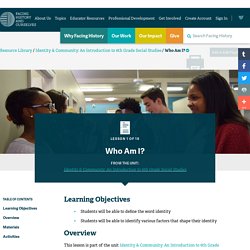
Is a question we all ask at some time in our lives. It is an especially critical question for adolescents. As we search for answers we begin to define ourselves. How is our identity formed? Bullying and social identity: The effects of group norms and distinctiveness threat on attitudes towards bullying - Ojala - 2004 - British Journal of Developmental Psychology. Drawing from social identity theory (Tajfel & Turner, 1979), an experiment was carried out to determine the extent to which children's attitudes towards bullying could be moderated by in-group norms and perceived threat to group distinctiveness.
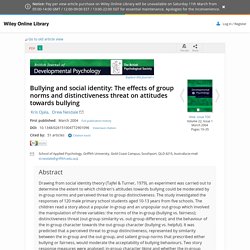
The study investigated the responses of 120 male primary school students aged 10-13 years from five schools. Freedom Writers (4/9) Movie CLIP - I Am Home (2007) HD. Image result for adolescent identit. Adolescence is no longer a bridge between childhood and adult life. Adolescence as an idea and as an experience grew out of the more general elevation of childhood as an ideal throughout the Western world.
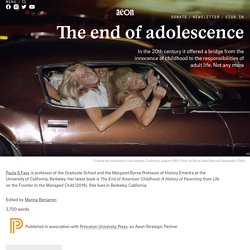
By the closing decades of the 19th century, nations defined the quality of their cultures by the treatment of their children. As Julia Lathrop, the first director of the United States Children’s Bureau, the first and only agency exclusively devoted to the wellbeing of children, observed in its second annual report, children’s welfare ‘tests the public spirit and democracy of a community’. Progressive societies cared for their children by emphasising play and schooling; parents were expected to shelter and protect their children’s innocence by keeping them from paid work and the wrong kinds of knowledge; while health, protection and education became the governing principles of child life.
Teaching Teen Identity. ACT for Youth - Adolescence - Adolescent Identity Development. The development of a strong and stable sense of self is widely considered to be one of the central tasks of adolescence [1].
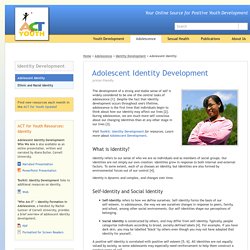
Despite the fact that identity development occurs throughout one's lifetime, adolescence is the first time that individuals begin to think about how our identity may affect our lives [2]. During adolescence, we are much more self-conscious about our changing identities than at any other stage in our lives [3]. Visit Toolkit: Identity Development for resources. Learn more about Adolescent Development. What is Identity? Shane Koyczan: "To This Day" ... for the bullied and beautiful. Darius Simpson & Scout Bostley - "Lost Voices" (CUPSI 2015)
What You Can Do for Students Living in Poverty. Erik Erikson’s Identity Crisis: Who am I? Adolescent Identity and Its Effects on Education. Video Documentaries March 2014. Lesson Plan: Identity: Defining Self, Choosing Friends. Download the Lesson Plan Jump to: In this lesson, students explore the factors that influence self-identity, which frequently evolves as adolescents negotiate life’s circumstances to find and secure their places in the world.
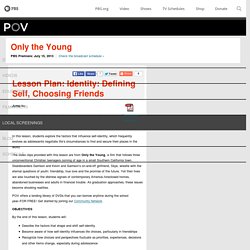
The video clips provided with this lesson are from Only the Young, a film that follows three unconventional Christian teenagers coming of age in a small Southern California town. Skateboarders Garrison and Kevin and Garrison’s on-and-off girlfriend, Skye, wrestle with the eternal questions of youth: friendship, true love and the promise of the future. Yet their lives are also touched by the distress signals of contemporary America–foreclosed homes, abandoned businesses and adults in financial trouble. POV offers a lending library of DVDs that you can borrow anytime during the school year–FOR FREE!
By the end of this lesson, students will: Language ArtsSocial StudiesCurrent Events Internet access and equipment to show the class online videoChart paper and markers 1. 2. How Does Poverty Influence Learning? Editor's note: This piece was adapted from Turning High-Poverty Schools into High-Performing Schools by William H. Parrett and Kathleen M. Budge. People in poverty are as diverse as people in any other socioeconomic class. They present, like other groups, a wide array of values, beliefs, dispositions, experiences, backgrounds, and life chances. As educators, in order to be responsive to the needs of our students, it is helpful to consider the constraints that poverty often places on people's lives, particularly children's, and how such conditions influence learning and academic achievement.